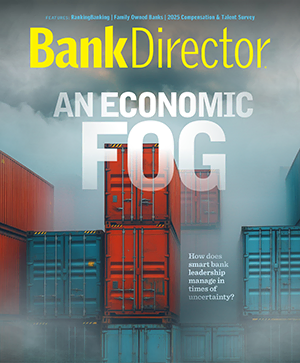As Director of Research at Janney Montgomery Scott, Chris Marinac oversees the firm’s Equity Research team, which covers more than 225 companies within the Financials, Healthcare, Infrastructure, and Real Estate sectors. The team aims to provide first class research on companies and the industry at large—which means staying ahead of the curve, understanding investors, and considering how events today will affect the future. Chris has more than 27 years of financial services and research analysis experience. Prior to joining Janney in 2019, he was Co-Founder and Director of Research at FIG Partners LLC, a premier investment banking and research firm specializing in community banks. At FIG, he established and managed an award-winning Equity Research team that covered more than 150 banks, thrifts, and REITs. Earlier in his career, he spent six years as Managing Director at SunTrust Robinson Humphrey and five years as a Research Analyst at Wachovia Corporation (formerly Interstate/Johnson Lane Inc.).

What Rising Bankruptcies Means for Banks
The increase in bankruptcies has definite ramifications on credit quality for banks and other lenders.
Brought to you by Janney Montgomery Scott LLC

*This article was published in Bank Director magazine’s third quarter 2024 issue.
Bankruptcies are rising.
The annualized pace for 2024 bankruptcy filings is just over 501,000 versus 445,200 in 2023 and 378,400 in 2022. But importantly, these levels remain below 2019’s levels.
Here’s a rundown of past bankruptcy filings:
There were 775,000 filings in 2019.
There were 1.59 million filings in 2010.
There were 2.09 million filings in the peak year of 2005.
This year’s bankruptcy pace (i.e., 501,000 filings) is 65% of 2019’s activity and just 32% of the 2010 level.
Additionally, corporate Chapter 11 filings, which help businesses reorganize, are 105% of 2019 levels and still 54% of bankruptcies in 2010, following the Great Financial Crisis, according to Epiq Global and the American Bankruptcy Institute.
Examining Emerging Trends
We believe that surpassing 2019 is an important threshold signaling that bankruptcy behavior is changing across the U.S. This has definite ramifications for credit quality for banks and other lenders in the U.S. financial system.
Likewise, we examined a separate angle on the data for Chapter 7 bankruptcies that include small businesses, otherwise known as liquidation. Fortunately, Chapter 7 filings are 59% of their 2019 level and only 25% of the 2010 experience. Chapter 13 bankruptcies, known as the wage earners’ plans, are slightly worse at 65% of their 2019 level using annualized filings from January 2024 through April 2024. The Chapter 13 filings are 43% of their 2010 level.
These trends should be compared with banks’ commercial and industrial (C&I) credit quality data, where we see modest deterioration in recent quarters on both past due and delinquent loans as well as net charge-offs.
Average C&I losses for banks with at least $1 billion in C&I loans were:
.51% or 51 basis points for the first quarter of 2024.
up from .38% a year ago.
well below the long-term average of 1.03% from 1999 to 2024.
Janney examined over 1,600 Federal Deposit Insurance Corp. call report filings for banks larger than $500 million in assets. The call report data has strong disclosure on average C&I balances and quarterly gross charge-offs, specifically in the C&I category, which makes the math easy.
The combined past due and nonaccural C&I loans:
averaged 1.34% as of March 31, 2024.
were up .99% from a year ago.
had a long-term average of 1.57%.
Past the Inflection Point
Overall, we think the inflection point has already occurred, and we anticipate greater problems and higher losses in general C&I loan exposures at U.S. banks and unregulated lenders. The same expectation holds for U.S. Small Business Administration credits and the non-guaranteed portion retained by certain lenders.
Investors should expect more reserve building by banks for C&I exposures, especially if the bankruptcy data rises further for the remainder of 2024 and again in 2025. This credit cycle is underway, in our opinion, and CRE worries are not the only item on our radar screen.
The good news is that banks have superb capacity to stomach these charge-offs given strong pre-tax, pre-provision net revenue, or PPNR, which enables loss recognition of 1.5% to 2% of loans outstanding each year. This PPNR equates to 4.5% to about 6% in loan losses over the next 36 months.
Why PPNR Matters
The PPNR loss capacity is critical for banks, directors and investors to understand and appreciate. The PPNR capacity allows banks to build reserves today to address possible credit losses tomorrow.
When banks address credit risk well in advance, our experience is that greater investor confidence follows. We encourage bank boards to ask questions about provisioning and credit loss trends, and we encourage banks to explain their PPNR as a level of loss capacity on future credit risk.
Yes, we understand that actual problems and write-offs may drive the maximum reserve-building in any given quarter due to GAAP accounting rules. The additional capacity to use current earnings or PPNR to address unforeseen credit risks and losses should be better explained and documented internally and externally, in our opinion.


